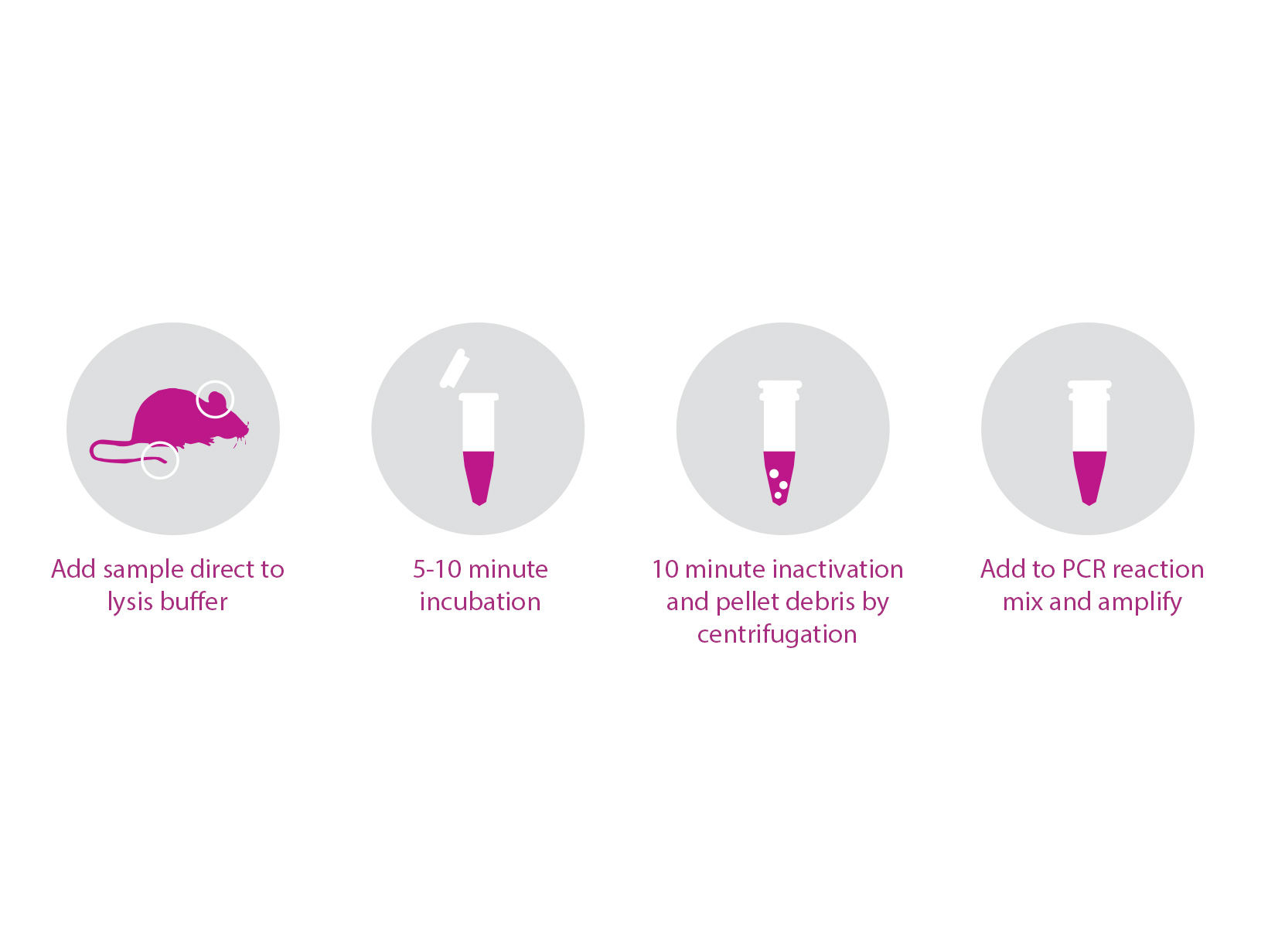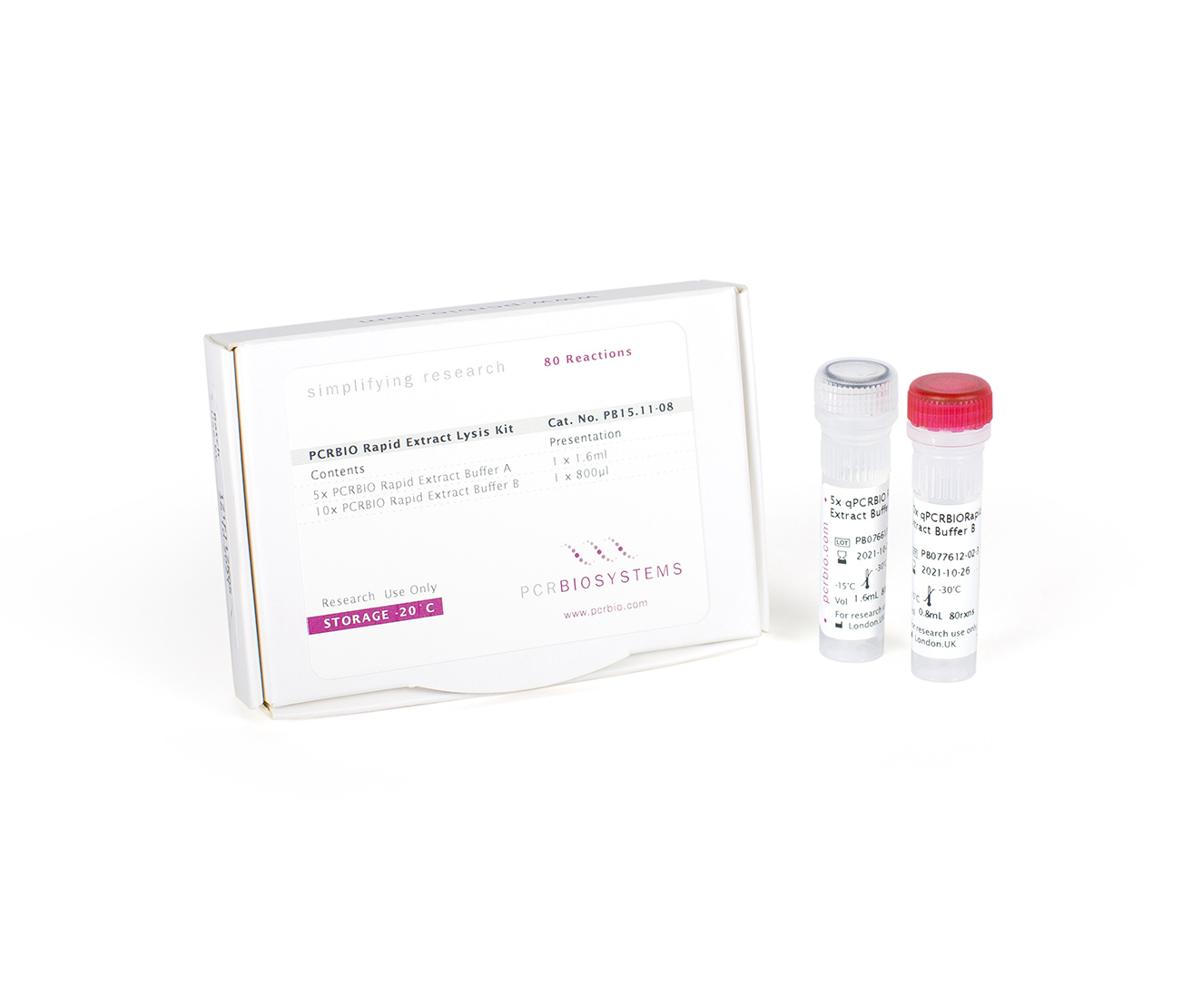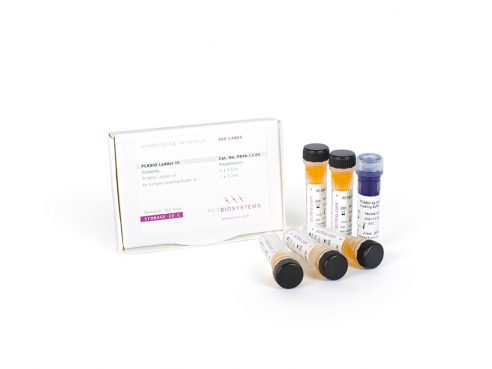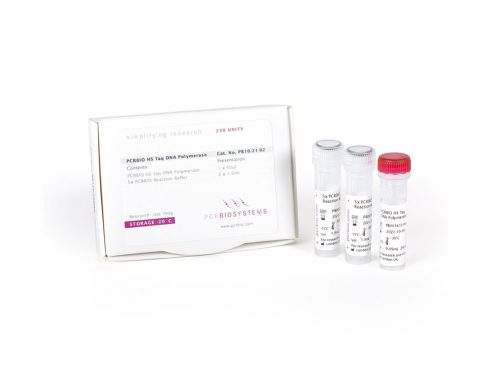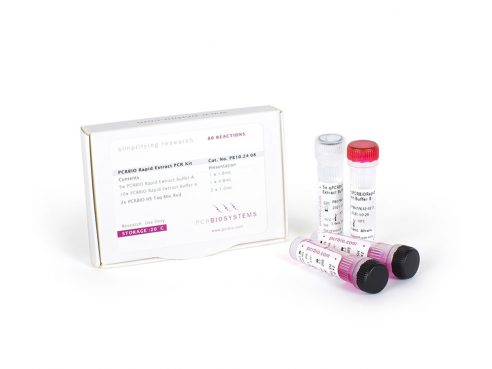To view your price please login or contact us
PCRBIO Rapid Extract Lysis Kit
PCRBIO Rapid Extract Lysis Kit makes extraction of PCR-ready DNA quick and easy.
Our advanced lysis and protease buffer system works with a variety of sample types, without the need for hazardous chemicals or multiple washing steps.
Features
- Rapid, convenient, single-tube DNA extraction
- Produces high yield, PCR-ready DNA in as little as 15 minutes
- Suitable for multiple sample types including mouse tail clip and ear punch, animal tissue, hair follicle, buccal swab, mammalian blood and FFPE tissue
- Single-tube extraction reduces potential contamination and sample loss
- No need for hazardous chemicals or multiple washing steps
More Information
PCRBIO Rapid Extract Lysis Kit offers rapid DNA extraction in a convenient, easy-to-use format. The kit contains a lysis and protease buffer system that allows the generation of PCR-ready DNA for use in downstream PCR or qPCR reactions.
Eliminate the need for laborious and time-consuming DNA extraction methods with this fast and simple kit which has been optimised for a variety of sample types. The kit is particularly suited to solid tissue such as mouse tail or mouse ear, and can also be used with soft tissue, hair follicle, buccal swab, mammalian blood and FFPE tissue.
Applications
- Genotyping
- Transgene detection
- Knockout analysis
- Sequencing
Specifications
PCRBIO Rapid Extract Lysis Kit
Component
80 Extractions
240 Extractions
5x PCRBIO Rapid Extract Buffer A
1 x 1.6 mL
3 x 1.6 mL
10x PCRBIO Rapid Extract Buffer B
1 x 800 μL
3 x 800 μL
PCRBIO Rapid Extract Lysis Kit
Component
5x PCRBIO Rapid Extract Buffer A
10x PCRBIO Rapid Extract Buffer B
80 Extractions
1 x 1.6 mL
1 x 800 μL
240 Extractions
3 x 1.6 mL
3 x 800 μL
Reaction Volume
Storage
100 μL
On arrival, products should be stored between -30 and -15 °C. If stored correctly the kit will retain full activity for 12 months.
Reaction Volume
100 μL
Storage
On arrival, products should be stored between -30 and -15 °C. If stored correctly the kit will retain full activity for 12 months.
Documents
Product Flyers
Product Manuals
Material Safety Data Sheets
Certificate of Analysis Finder
FAQs
Can I use PCRBIO Rapid Extract Lysis Kit to extract and amplify DNA from a few dozen cells on filter paper?
Our PCR mixes work reliably with 10 or more copies of template per reaction but not lower than that. Keep the extracted DNA in the lowest volume possible and don’t dilute further after inactivating the protease. We advise setting up the assay with more cells and once the conditions are established, scaling it down from there.
Can PCRBIO Rapid Extract Lysis Kit be used to extract and amplify DNA from a single colony or from a bacterial cell lysate?
Yes, it can be used to amplify DNA from bacterial colonies or bacterial cell lysate however, it’s not necessary to use the Rapid Extract Lysis Kit in order to perform routine colony PCR. If you’re working from bacterial colonies use a sterile tip to pick a colony and resuspend into the 50µl PCR reaction. If working from liquid culture add 5µl of overnight culture to the final mix. Follow the general protocol and increase the initial denaturation time to 10 min at 95°C.
For qPCR, it may be important to extract DNA with the PCRBIO Rapid Extract Lysis Kit to decrease background noise and control the amount of DNA added to the reaction.
Can the extracted DNA be stored long-term at -20 degrees Celsius?
We recommend storing the extracted DNA at -20°C in the short term but for long term storage, we recommend purifying the DNA and re-suspending it in a standard buffer.
Can the extracted DNA be used for qPCR?
Yes, PCRBIO Rapid Extract Lysis Kit can be used to create template for qPCR. Use PCRBIO Rapid Extract Lysis Kit to prepare the template, and then use that template in a qPCR reaction as specified by the qPCR kit instructions.
Could the extracted DNA be amplified by polymerases that are not from PCRBIO?
The extracted DNA should be suitable for another manufacturer’s PCR kit.
Is it critical to deactivate the protease at 95 degrees Celsius?
Protease is a very active enzyme, and if it isn’t properly deactivated through the heat denaturation step, it could quickly degrade the polymerase during the PCR step.
What are the required conditions to break up feathers prior to using PCRBIO Rapid Extract Lysis Kit?
200 mM DTT should be added to the feather and left to incubate overnight in order to break up the keratin.
What is included in PCRBIO Rapid Extract Lysis Kit?
5x PCRBIO Rapid Extract Buffer A (Lysis buffer) and 10x PCRBIO Rapid Extract Buffer B (Protease buffer).
What is the difference between PCRBIO Rapid Extract Lysis Kit and PCRBIO Rapid Extract PCR Kit?
PCRBIO Rapid Extract PCR Kit has the same contents as PCRBIO Rapid Extract Lysis Kit plus PCRBIO HS Taq Mix Red for subsequent PCR amplification.
What size of FFPE do you recommend?
For Formalin-Fixed Paraffin-Embedded (FFPE) tissue specimens, we recommend 1 – 2 mm2 of a 10 µm cross-section. If you use less than that, you may not get enough DNA for PCR.
Which samples can be used with PCRBIO Rapid Extract Lysis Kit?
PCRBIO Rapid Extract Lysis Kit was tested with the following list of tissues:
- Mammalian cell cultures
- Animal tissues from a variety of organisms (Fish, lobster, Mice tails / ears, Zebrafish, Nematodes, Kidney, Hair Follicle)
- Insects like Drosophila, mosquitos, beetle (legs, wings)
- Buccal swabs
- Gram positive bacteria
- Fungal Mycelia
- Stool samples
- FFPE
- Blood1
- Fish Scale clips
The following tissues can require a pre-wash step before starting the PCRBIO Rapid Extract protocol2
- Yeast2,3 (pre-wash or digestion with zymolase to obtain spheroblasts)
- Feather4 (requires modification of the protocol see below )
- Stool sample5 (requires dilution series to get rid of inhibitors)
If you have a small amount of starting material, we recommend keeping the extracted DNA in the lowest volume possible and to avoid any further dilutions after inactivating the protease.
1 Batubara, A. et al. 2016. Study of BMP15 gene polymorphism in Boer, Kacang, and Boerka goats. Jurnal Ilmu Ternak Dan Veteriner 21(4): 224-230. DOI: http://dx.doi.org/10.14334/jitv.v21i4.1636 (2016).
2 Inglis, P.W. et al. 2018. Fast and inexpensive protocols for consistent extraction of high quality DNA and RNA from challenging plant and fungal samples for high throughput SNP genotyping and sequencing Applications. PLOS ONE | https://doi.org/10.1371/journal.pone.0206085 October 18.
3 Suzuki, T. & Iwahashi, Y. 2013. RNA preparation of Saccharomyces cerevisiae using the digestion method may give misleading results. Appl Biochem Biotechnol 169:1620–1632
DOI 10.1007/s12010-012-0051-8
4 Bello, N. et al. 2001. Isolation of genomic DNA from feathers. J Vet Diagn Invest 13:162–164
5 Nantavisai, K. et al. 2007. Evaluation of the sensitivities of DNA extraction and PCR methods for detection of Giardia duodenalisin stool specimens. J. Clinical Microbiology. 45: 581–583 doi:10.1128/JCM.01823-06
Why has the colour of the supernatant changed?
Changes in the colouration of the supernatant could be due to either pigments being released from the tissue into the supernatant or a change of pH. Changes in the supernatant colouration don’t necessarily affect the PCR reaction.
Would downstream PCR reactions work if my sample has a high level of inhibitors (like in blood and stool samples)?
PCRBIO Rapid Extract Lysis Kit can be used with human blood however, blood components may inhibit the PCR reaction. Therefore, it’s a good idea to perform a serial dilution of the extracted DNA in order to find the optimal template concentration for the PCR amplification.
If the amplification is less than optimal, we recommend performing an isopropanol/acetate precipitation of the DNA prior to the PCR reaction.
More Information
PCRBIO Rapid Extract Lysis Kit offers rapid DNA extraction in a convenient, easy-to-use format. The kit contains a lysis and protease buffer system that allows the generation of PCR-ready DNA for use in downstream PCR or qPCR reactions.
Eliminate the need for laborious and time-consuming DNA extraction methods with this fast and simple kit which has been optimised for a variety of sample types. The kit is particularly suited to solid tissue such as mouse tail or mouse ear, and can also be used with soft tissue, hair follicle, buccal swab, mammalian blood and FFPE tissue.
Applications
- Genotyping
- Transgene detection
- Knockout analysis
- Sequencing
Specifications
PCRBIO Rapid Extract Lysis Kit
Component
80 Extractions
240 Extractions
5x PCRBIO Rapid Extract Buffer A
1 x 1.6 mL
3 x 1.6 mL
10x PCRBIO Rapid Extract Buffer B
1 x 800 μL
3 x 800 μL
PCRBIO Rapid Extract Lysis Kit
Component
5x PCRBIO Rapid Extract Buffer A
10x PCRBIO Rapid Extract Buffer B
80 Extractions
1 x 1.6 mL
1 x 800 μL
240 Extractions
3 x 1.6 mL
3 x 800 μL
Reaction Volume
Storage
100 μL
On arrival, products should be stored between -30 and -15 °C. If stored correctly the kit will retain full activity for 12 months.
Reaction Volume
100 μL
Storage
On arrival, products should be stored between -30 and -15 °C. If stored correctly the kit will retain full activity for 12 months.
Documents
Product Flyers
Product Manuals
Material Safety Data Sheets
Certificate of Analysis Finder
FAQs
Can I use PCRBIO Rapid Extract Lysis Kit to extract and amplify DNA from a few dozen cells on filter paper?
Our PCR mixes work reliably with 10 or more copies of template per reaction but not lower than that. Keep the extracted DNA in the lowest volume possible and don’t dilute further after inactivating the protease. We advise setting up the assay with more cells and once the conditions are established, scaling it down from there.
Can PCRBIO Rapid Extract Lysis Kit be used to extract and amplify DNA from a single colony or from a bacterial cell lysate?
Yes, it can be used to amplify DNA from bacterial colonies or bacterial cell lysate however, it’s not necessary to use the Rapid Extract Lysis Kit in order to perform routine colony PCR. If you’re working from bacterial colonies use a sterile tip to pick a colony and resuspend into the 50µl PCR reaction. If working from liquid culture add 5µl of overnight culture to the final mix. Follow the general protocol and increase the initial denaturation time to 10 min at 95°C.
For qPCR, it may be important to extract DNA with the PCRBIO Rapid Extract Lysis Kit to decrease background noise and control the amount of DNA added to the reaction.
Can the extracted DNA be stored long-term at -20 degrees Celsius?
We recommend storing the extracted DNA at -20°C in the short term but for long term storage, we recommend purifying the DNA and re-suspending it in a standard buffer.
Can the extracted DNA be used for qPCR?
Yes, PCRBIO Rapid Extract Lysis Kit can be used to create template for qPCR. Use PCRBIO Rapid Extract Lysis Kit to prepare the template, and then use that template in a qPCR reaction as specified by the qPCR kit instructions.
Could the extracted DNA be amplified by polymerases that are not from PCRBIO?
The extracted DNA should be suitable for another manufacturer’s PCR kit.
Is it critical to deactivate the protease at 95 degrees Celsius?
Protease is a very active enzyme, and if it isn’t properly deactivated through the heat denaturation step, it could quickly degrade the polymerase during the PCR step.
What are the required conditions to break up feathers prior to using PCRBIO Rapid Extract Lysis Kit?
200 mM DTT should be added to the feather and left to incubate overnight in order to break up the keratin.
What is included in PCRBIO Rapid Extract Lysis Kit?
5x PCRBIO Rapid Extract Buffer A (Lysis buffer) and 10x PCRBIO Rapid Extract Buffer B (Protease buffer).
What is the difference between PCRBIO Rapid Extract Lysis Kit and PCRBIO Rapid Extract PCR Kit?
PCRBIO Rapid Extract PCR Kit has the same contents as PCRBIO Rapid Extract Lysis Kit plus PCRBIO HS Taq Mix Red for subsequent PCR amplification.
What size of FFPE do you recommend?
For Formalin-Fixed Paraffin-Embedded (FFPE) tissue specimens, we recommend 1 – 2 mm2 of a 10 µm cross-section. If you use less than that, you may not get enough DNA for PCR.
Which samples can be used with PCRBIO Rapid Extract Lysis Kit?
PCRBIO Rapid Extract Lysis Kit was tested with the following list of tissues:
- Mammalian cell cultures
- Animal tissues from a variety of organisms (Fish, lobster, Mice tails / ears, Zebrafish, Nematodes, Kidney, Hair Follicle)
- Insects like Drosophila, mosquitos, beetle (legs, wings)
- Buccal swabs
- Gram positive bacteria
- Fungal Mycelia
- Stool samples
- FFPE
- Blood1
- Fish Scale clips
The following tissues can require a pre-wash step before starting the PCRBIO Rapid Extract protocol2
- Yeast2,3 (pre-wash or digestion with zymolase to obtain spheroblasts)
- Feather4 (requires modification of the protocol see below )
- Stool sample5 (requires dilution series to get rid of inhibitors)
If you have a small amount of starting material, we recommend keeping the extracted DNA in the lowest volume possible and to avoid any further dilutions after inactivating the protease.
1 Batubara, A. et al. 2016. Study of BMP15 gene polymorphism in Boer, Kacang, and Boerka goats. Jurnal Ilmu Ternak Dan Veteriner 21(4): 224-230. DOI: http://dx.doi.org/10.14334/jitv.v21i4.1636 (2016).
2 Inglis, P.W. et al. 2018. Fast and inexpensive protocols for consistent extraction of high quality DNA and RNA from challenging plant and fungal samples for high throughput SNP genotyping and sequencing Applications. PLOS ONE | https://doi.org/10.1371/journal.pone.0206085 October 18.
3 Suzuki, T. & Iwahashi, Y. 2013. RNA preparation of Saccharomyces cerevisiae using the digestion method may give misleading results. Appl Biochem Biotechnol 169:1620–1632
DOI 10.1007/s12010-012-0051-8
4 Bello, N. et al. 2001. Isolation of genomic DNA from feathers. J Vet Diagn Invest 13:162–164
5 Nantavisai, K. et al. 2007. Evaluation of the sensitivities of DNA extraction and PCR methods for detection of Giardia duodenalisin stool specimens. J. Clinical Microbiology. 45: 581–583 doi:10.1128/JCM.01823-06
Why has the colour of the supernatant changed?
Changes in the colouration of the supernatant could be due to either pigments being released from the tissue into the supernatant or a change of pH. Changes in the supernatant colouration don’t necessarily affect the PCR reaction.
Would downstream PCR reactions work if my sample has a high level of inhibitors (like in blood and stool samples)?
PCRBIO Rapid Extract Lysis Kit can be used with human blood however, blood components may inhibit the PCR reaction. Therefore, it’s a good idea to perform a serial dilution of the extracted DNA in order to find the optimal template concentration for the PCR amplification.
If the amplification is less than optimal, we recommend performing an isopropanol/acetate precipitation of the DNA prior to the PCR reaction.




